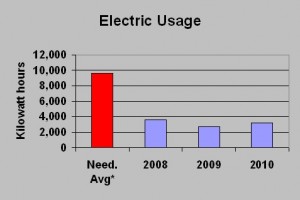Garden Philosophy –
Create a small, beautiful and bountiful, local eco-system using as little input from outside as possible. This includes feeding the soil, watering and our choice of plants. We have a large flowerbed and grow about $500 of vegetables and fruits ourselves, many of them perennial, using our own compost, one bottle of fish emulsion and one bottle of spinosad. Take the walk around the garden with the map to check it out.

Components –
1) Neighborhood Farm plot (H) – 800 sf of the garden is maintained by the Neighborhood Farm of Needham to produce local food and flowers, sold at Dedham and Roslindale Farmer’s markets, and for which we receive an exchange of food (not included in the $500 we grow ourselves).
2) Needham Community Farm greenhouse (L) – the geodesic dome is where we’re growing seedlings this year for the Pine Street (formerly Nike) location. Our own seedlings grow in pots made of newspaper.
3) Perennial flowerbeds with local plants needing no extra watering (XX).
4) Perennial crops: apple trees (A), rhubarb (B), strawberries (C), asparagus (E), purslane (I), blueberries (J), jerusalem artichokes (K), fiddleheads (N), raspberries (P), currants (T), blackberries (V), sour cherries (W), crab apples for pectin (X), highbush cranberries (Y), elderberries (Z), winecap mushrooms (MM).
5) Perennial/self-seeding herbs: peppermint (M), oregano (Q), sage (R), lavender (S), cilantro, dill, chives (U).
6) Annual vegetables: in four beds around the garden (F). To maintain soil tilth and nutrients, we use crop rotation, annual compost additions from three compost heaps (O), and a little fish emulsion. For stakes, we use pruned branches; to protect against cutworms, rings from yoghurt containers.
7) Bees – to help save the bees, crop pollination, and perhaps one day, to harvest our own honey.
8 ) Compost – foodscraps, old paper, and our and our neighbors’ leaves, in three locations (O). One bin is next to the blackberries so the compost moisture draining into the soil will feed them.
9) Mushrooms – winecaps in the flowerbed and among vegetables (MM), mushroom logs with shiitake, oyster and chicken of the woods (MN) – put in last fall, the logs have yet to fruit (!).
Low-impact house philosophy –
Live a comfortable modern life, mindful of the resources we use, and taking advantage of simple and cost-effective opportunities to save energy.
Components –
1) Small is beautiful – we have stayed within the original walls of our historical home, 1300 sq ft plus attic and basement, renovating to beautify rather than enlarge spaces, and find our family (4) fits comfortably.
2) Heating with passive solar energy – the large windows facing south into the garden provide lots of warmth in the second half of winter. Other ways we save on gas heating is with a programmable thermostat, high-efficiency furnace, and a high efficiency wood stove (in which we burn local wood).
3) Staying cool with breezes and outdoor spaces – it gets hot in summer without air conditioning, but we find our bodies gradually adjust and we like the months of fresh air. To make this work, we cross-ventilate the house by opening windows at night, use fans (we love ceiling fans), have protective glazing on west-facing windows, have big trees to shade part of the house. In the evening and morning we eat outside where it is cooler, and we sleep outside in a tent on the hottest nights in the dog days of summer.
4) Simple electricity savings – I’m told that we use comparatively little electricity ($60/month), but we don’t feel we’re missing out on anything. We do use compact fluorescent lights and turn them off when we’re not in the room, have all energy star appliances – refrigerator, dishwasher, washing machine, three computers –, and hang our clothes on a clothesline to dry. I guess small steps add up.

